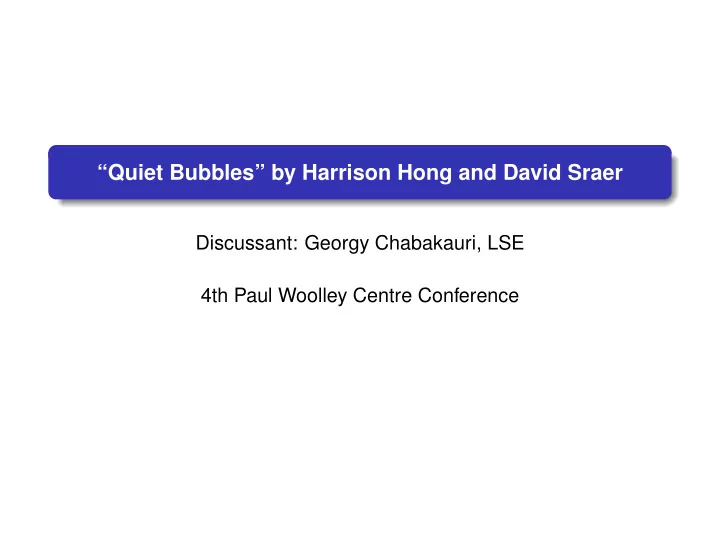

“Quiet Bubbles” by Harrison Hong and David Sraer Discussant: Georgy Chabakauri, LSE 4th Paul Woolley Centre Conference
Discussion Model Overview In contrast to equity bubbles credit bubble of 2003-2007 was quiet: prices were high but price volatility and turnover were low Bubble in the economy is generated by investor disagreement and short-sale constraints (e.g. Miller, 1977) giving rise to a resale option in a dynamic setting (similarly to Harrison and Kreps, 1978; Scheinkman and Xiong, 2003) In contrast to classic models of equity bubbles the pricing of debt security is considered. bubble = resale option + optimism - The valuation of debt is less sensitive to disagreement due to bounded up-side payoff - Consequently, debt bubble is smaller and quieter due to smaller resale value Georgy Chabakauri (LSE) “Quiet Bubbles” by Hong and Sraer 2 / 9
Discussion Model Overview (cont’d) Model has three dates t = 0 , 1 , 2 , a risk-free asset and a risky debt contract with face value D with payoff at t = 2 given by: m 2 = min( D, ˜ ˜ ˜ G 2 ) , where G = G + ǫ 2 Risky asset in net supply Q , investors borrow at interest rate 1 /µ − 1 and face short-sale constraints and transaction costs. Investors’ beliefs are as follows: - At time 0 both investors believe that: ˜ V 2 = G + b + ǫ 2 - At time 1 beliefs change stochastically: ˜ V 2 = G + b + η i + ǫ 2 , i = A, B Investors solve the following dynamic optimization problem: n 0 + n 2 � − 1 � � � 0 + E η [ J ( n 0 , η i , P 1 )] max (1) µ 2 γ n 0 ,n 0 > 0 where ( n 1 − n 0 ) P 1 + ( n 1 − n 0 ) 2 � m 2 | η ] − 1 � �� max n 1 E [ ˜ (2) µ 2 γ n 1 ,n 1 > 0 Georgy Chabakauri (LSE) “Quiet Bubbles” by Hong and Sraer 3 / 9
Discussion Model Assumptions Implosion of the bubble is not modeled: - This can be done along the lines of Hong, Scheinkman, Xiong (2006) However, it might still be interesting to model implosion given that shorting was done differently from equity bubbles. It was possible to bet against the bubble by buying “naked” CDSes, which did not involve buying/holding underlying assets. This may have implications for the trading volume during the crisis. Georgy Chabakauri (LSE) “Quiet Bubbles” by Hong and Sraer 4 / 9
Discussion Model Assumptions (cont’d) Even though investors are symmetric at date 0 there will be a bubble due to beliefs shock in the future Optimization problem implies that even though investors agree at time- 0 they know that they will disagree in the future. How critical is this assumption for the analysis? Anecdotal accounts (e.g. Lewis, 2010) suggest that investors with initially positive views on CDOs were surprised with the poor quality of underlying assets later on (model by Gennaioli, Shleifer and Vishny (2010) builds on similar). Hence, investors might have failed to account for possible future divergence of beliefs in their portfolio choice decisions at time 0 (i.e. in 2003-2004). Would be interesting to find more direct evidence that the bubble was caused by the infiltration of anticipated future disagreement into date 0 prices. Georgy Chabakauri (LSE) “Quiet Bubbles” by Hong and Sraer 5 / 9
Discussion Model Assumptions (cont’d) The paper explains the anecdotal evidence that credit bubble caught everyone by surprise by the fact that smart investors were mislead by low price volatility Such an explanation implies that beliefs endogenously depend on volatility (e.g. due to learning). Is it possible to formally endogenize this dependence? The fact that many smart investors were caught by surprise may imply that the role of the heterogeneity of beliefs might have been limited Georgy Chabakauri (LSE) “Quiet Bubbles” by Hong and Sraer 6 / 9
Discussion Alternative Models Brunnermeier (2009) points out that by early 2007 many observers were concerned about credit bubble, but reluctant to bet against it This attitude was summed up by Chuck Prince of Citigroup: “...as long as music is playing, you’ve got to get up and dance” Consequently, even for pessimists it might have been profitable to “ride the wave” (e.g. Abreu and Brunnermeier, 2003) It would be interesting to see whether the credit bubble still will be quiet in Abreu-Brunnermeier type model Georgy Chabakauri (LSE) “Quiet Bubbles” by Hong and Sraer 7 / 9
Discussion Alternative Models (cont’d) Perceived diversification benefits made CDOs look less risky than they actually were. As argued in Gennaioli, Shleifer and Vishny (2010) AAA rated asset backed securities were perceived as substitutes to Treasury securities. Underestimation of the correlation risk boosted the valuation of AAA rated tranches (e.g., Brunnermeier, 2009; Coval, Jurek, and Stafford, 2010) beyond values justified by fundamentals, leading to a bubble. Low price volatility and low trading volume also might be due to CDOs being perceived as securities with low risks. Consequently, the bubble was quiet Georgy Chabakauri (LSE) “Quiet Bubbles” by Hong and Sraer 8 / 9
Discussion Conclusion Great paper that provides a unified framework to study both equity and credit bubbles! It complements the literature on financial crisis by providing a new explanation for the bubble It explains why the credit bubble of 2003-2007 was quiet Overall, very interesting paper that provides new insights about the financial crises, though it remains to be assessed empirically how significant were some of the economic forces identified in the paper. Georgy Chabakauri (LSE) “Quiet Bubbles” by Hong and Sraer 9 / 9
Recommend
More recommend